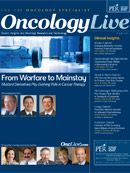Publication
Article
Oncology Live®
Colorectal Tumor Marker: Molecular Evaluation Sheds Light on Negative Lymph Node Status
Author(s):
The presence or absence of lymph node involvement has long been recognized as a critically relevant prognostic factor in solid tumor oncology.

Maurie Markman, MD
Editor-in-Chief of OncologyLive
Senior vice president for Clinical Affairs and National Director for Medical Oncology Cancer Treatment Centers of America, Eastern Regional Medical Center
The presence or absence of lymph node involvement has long been recognized as a critically relevant prognostic factor in solid tumor oncology. While local and regional lymph nodes are no longer viewed as serving a “barrier function,” the documented presence of cancer within these anatomical areas provides important data regarding the statistical likelihood that a particular malignancy has spread to distant sites.
At the same time, it is also well understood that individual cancers may have metastasized at the time of diagnosis, even without the documented presence of malignant cells within local nodes. This well-established observation raises the provocative question of whether the disease involved nodes prior to further dissemination or, conversely, whether the finding of “negative nodes” is often simply an artifact of the inherent insensitivity of existing diagnostic tools.
The question is highly clinically relevant in colorectal cancer, since adjuvant chemotherapy is known to improve both progression-free and overall survival in patients with lymph node-positive nonmetastatic disease. Thus, patients labeled as having “node-negative” disease, when the cancer is actually more advanced, will be denied the opportunity to receive systemic antineoplastic therapy at a point in the natural history of the malignancy where the ultimate survival outcome may be most favorably impacted by its use.
This issue was recently addressed in an interesting analysis involving a group of patients with “nodenegative” colorectal cancer. Hyslop et al noted that approximately one-fourth of patients with negativenode status experience a recurrence of disease and set out to explore the relationship between molecular tumor burden in lymph nodes and outcomes (Clin Cancer Res. 2011;17(10):3293-3303).
In this particular research effort, the “noncancer bearing” lymph nodes were examined for the presence of guanylyl cyclase 2C (GUCY2C), a family of proteins that synthesizes cyclic guanosine monophosphate. GUCY2C is a previously documented sensitive marker of the presence of malignant colorectal cancer, established through the technique of reverse transcriptase polymerase chain reaction (PCR).
The study included 291 patients (55% male), with 84% having >12 nodes removed at the time of surgery. The tumor grade was well or moderately differentiated in 85% of cases, and 15% were classified either as poorly differentiated or the grade was unknown. Lymphovascular invasion was present in 20% of the population.
Approximately 25% of patients whose colorectal malignancies are assessed as node-negative experience a recurrence, raising provocative questions that a novel tumor marker may help answer.
Based on the laboratory findings, the patients were divided into 3 groups with a predicted quantitative tumor burden. The low, intermediate, and high tumor burden populations comprised 60%, 31%, and 9% of the total, respectively. Of considerable interest, the recurrence rates documented within these 3 groups (median follow-up of 2 years) was found to be 2.3%, 33.3%, and 68%, respectively. Not surprisingly, the 3 patient populations were also shown to experience different overall survival rates consistent with their relative observed risk of recurrence.
Finally, the investigators concluded that in this analysis the molecular tumor burden was an independent predictor of outcome.
It is important to emphasize that the results in this analysis will need to be confirmed by other investigators evaluating independent data sets. However, assuming such studies reveal similar outcomes, it would be reasonable to suggest that this type of quantitative molecular analysis may play an important role in routine management of colorectal cancer patients discovered on initial histopathology review to have no evidence of malignant involvement of local or regional lymph nodes.
In addition to providing refined prognostic data for a specific patient, the results of this study strongly support the conclusion that this type of molecular analysis of lymph node involvement is associated with a far more accurate assessment of the population of individuals who would be predicted to benefit from adjuvant chemotherapy following definitive surgical staging and tumor removal.
Finally, it is also reasonable to speculate that future research efforts will be successful in defining specific molecular markers in other malignancies that may more definitively separate patient populations with and without local/regional nodal involvement, permitting both more meaningful prognostic data regarding the ultimate risk of recurrence and—of greatest importance—predictive information that can be used by clinicians to select a management program to optimize outcome.










